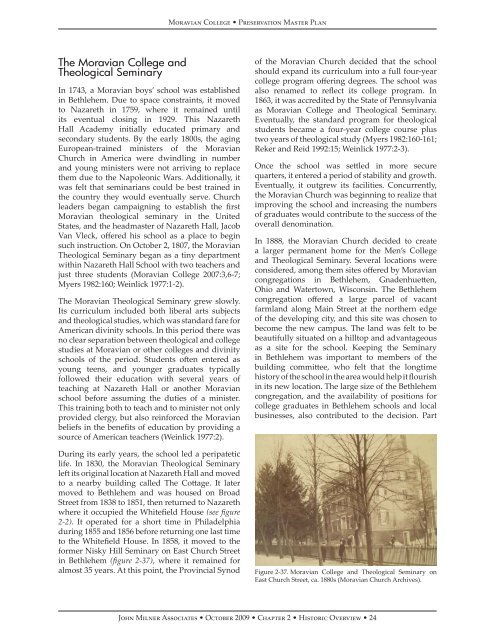Moravian Preservation Master Plan.indb - Society for College and ...
Moravian Preservation Master Plan.indb - Society for College and ...
Moravian Preservation Master Plan.indb - Society for College and ...
You also want an ePaper? Increase the reach of your titles
YUMPU automatically turns print PDFs into web optimized ePapers that Google loves.
<strong>Moravian</strong> <strong>College</strong> • <strong>Preservation</strong> <strong>Master</strong> <strong>Plan</strong><br />
The <strong>Moravian</strong> <strong>College</strong> <strong>and</strong><br />
Theological Seminary<br />
In 1743, a <strong>Moravian</strong> boys’ school was established<br />
in Bethlehem. Due to space constraints, it moved<br />
to Nazareth in 1759, where it remained until<br />
its eventual closing in 1929. This Nazareth<br />
Hall Academy initially educated primary <strong>and</strong><br />
secondary students. By the early 1800s, the aging<br />
European-trained ministers of the <strong>Moravian</strong><br />
Church in America were dwindling in number<br />
<strong>and</strong> young ministers were not arriving to replace<br />
them due to the Napoleonic Wars. Additionally, it<br />
was felt that seminarians could be best trained in<br />
the country they would eventually serve. Church<br />
leaders began campaigning to establish the first<br />
<strong>Moravian</strong> theological seminary in the United<br />
States, <strong>and</strong> the headmaster of Nazareth Hall, Jacob<br />
Van Vleck, offered his school as a place to begin<br />
such instruction. On October 2, 1807, the <strong>Moravian</strong><br />
Theological Seminary began as a tiny department<br />
within Nazareth Hall School with two teachers <strong>and</strong><br />
just three students (<strong>Moravian</strong> <strong>College</strong> 2007:3,6-7;<br />
Myers 1982:160; Weinlick 1977:1-2).<br />
The <strong>Moravian</strong> Theological Seminary grew slowly.<br />
Its curriculum included both liberal arts subjects<br />
<strong>and</strong> theological studies, which was st<strong>and</strong>ard fare <strong>for</strong><br />
American divinity schools. In this period there was<br />
no clear separation between theological <strong>and</strong> college<br />
studies at <strong>Moravian</strong> or other colleges <strong>and</strong> divinity<br />
schools of the period. Students often entered as<br />
young teens, <strong>and</strong> younger graduates typically<br />
followed their education with several years of<br />
teaching at Nazareth Hall or another <strong>Moravian</strong><br />
school be<strong>for</strong>e assuming the duties of a minister.<br />
This training both to teach <strong>and</strong> to minister not only<br />
provided clergy, but also rein<strong>for</strong>ced the <strong>Moravian</strong><br />
beliefs in the benefits of education by providing a<br />
source of American teachers (Weinlick 1977:2).<br />
During its early years, the school led a peripatetic<br />
life. In 1830, the <strong>Moravian</strong> Theological Seminary<br />
left its original location at Nazareth Hall <strong>and</strong> moved<br />
to a nearby building called The Cottage. It later<br />
moved to Bethlehem <strong>and</strong> was housed on Broad<br />
Street from 1838 to 1851, then returned to Nazareth<br />
where it occupied the Whitefield House (see figure<br />
2-2). It operated <strong>for</strong> a short time in Philadelphia<br />
during 1855 <strong>and</strong> 1856 be<strong>for</strong>e returning one last time<br />
to the Whitefield House. In 1858, it moved to the<br />
<strong>for</strong>mer Nisky Hill Seminary on East Church Street<br />
in Bethlehem (figure 2-37), where it remained <strong>for</strong><br />
almost 35 years. At this point, the Provincial Synod<br />
of the <strong>Moravian</strong> Church decided that the school<br />
should exp<strong>and</strong> its curriculum into a full four-year<br />
college program offering degrees. The school was<br />
also renamed to reflect its college program. In<br />
1863, it was accredited by the State of Pennsylvania<br />
as <strong>Moravian</strong> <strong>College</strong> <strong>and</strong> Theological Seminary.<br />
Eventually, the st<strong>and</strong>ard program <strong>for</strong> theological<br />
students became a four-year college course plus<br />
two years of theological study (Myers 1982:160-161;<br />
Reker <strong>and</strong> Reid 1992:15; Weinlick 1977:2-3).<br />
Once the school was settled in more secure<br />
quarters, it entered a period of stability <strong>and</strong> growth.<br />
Eventually, it outgrew its facilities. Concurrently,<br />
the <strong>Moravian</strong> Church was beginning to realize that<br />
improving the school <strong>and</strong> increasing the numbers<br />
of graduates would contribute to the success of the<br />
overall denomination.<br />
In 1888, the <strong>Moravian</strong> Church decided to create<br />
a larger permanent home <strong>for</strong> the Men’s <strong>College</strong><br />
<strong>and</strong> Theological Seminary. Several locations were<br />
considered, among them sites offered by <strong>Moravian</strong><br />
congregations in Bethlehem, Gnadenhuetten,<br />
Ohio <strong>and</strong> Watertown, Wisconsin. The Bethlehem<br />
congregation offered a large parcel of vacant<br />
farml<strong>and</strong> along Main Street at the northern edge<br />
of the developing city, <strong>and</strong> this site was chosen to<br />
become the new campus. The l<strong>and</strong> was felt to be<br />
beautifully situated on a hilltop <strong>and</strong> advantageous<br />
as a site <strong>for</strong> the school. Keeping the Seminary<br />
in Bethlehem was important to members of the<br />
building committee, who felt that the longtime<br />
history of the school in the area would help it flourish<br />
in its new location. The large size of the Bethlehem<br />
congregation, <strong>and</strong> the availability of positions <strong>for</strong><br />
college graduates in Bethlehem schools <strong>and</strong> local<br />
businesses, also contributed to the decision. Part<br />
Figure 2-37. <strong>Moravian</strong> <strong>College</strong> <strong>and</strong> Theological Seminary on<br />
East Church Street, ca. 1880s (<strong>Moravian</strong> Church Archives).<br />
John Milner Associates • October 2009 • Chapter 2 • Historic Overview • 24

















